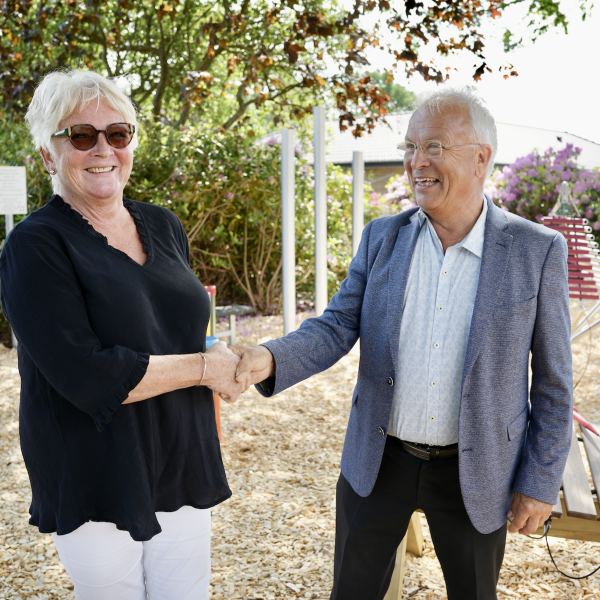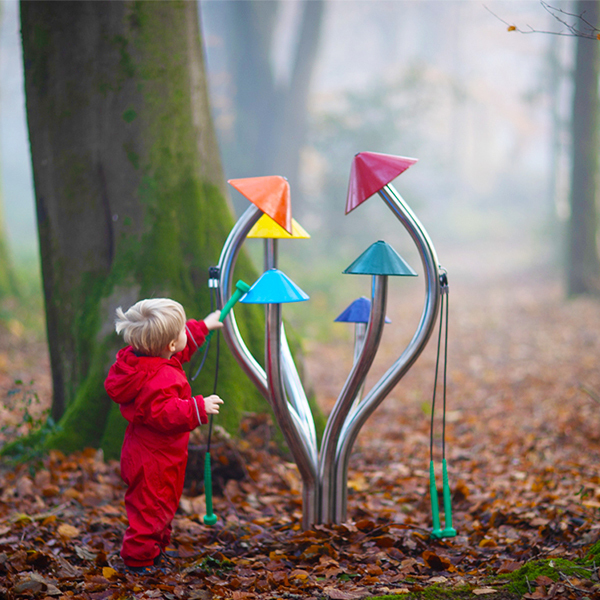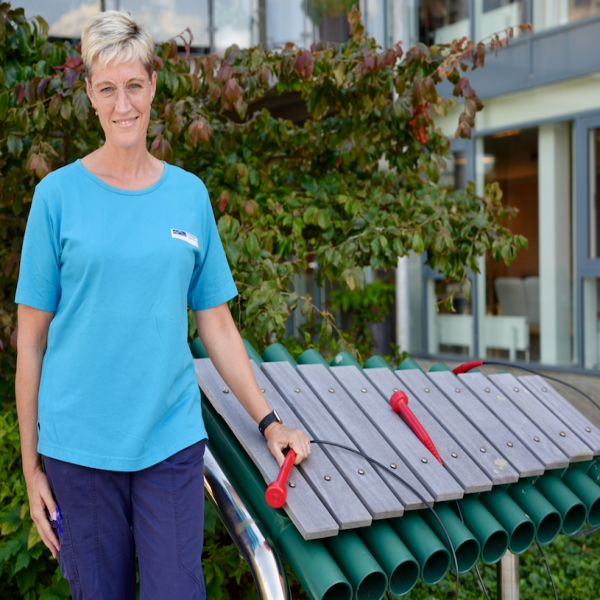Danish Care Home Residents Musical Garden
Article from PLEJE (CARE) Magazine: New Notes at the Care Centre
Trollemose Care Centre in Svendborg, Denmark are delighted with the new outdoor musical instruments they now have in their garden.
Originally, the Care Centre was looking for something new and interesting for the residents to look at in the garden. But then they heard about outdoor musical instruments.
“There’s something very special about these musical instruments that attracts people to them. You simply can’t resist walking up to them and striking them just to hear the sound that comes out of them” says Section Manager at Trollemose Care centre, Agnete Bille.
And with help from the Trollevenner Voluntary Association, who applied for money from the Municipality’s funding pool for ‘the prevention of loneliness among the elderly’, they bought two outdoor xylophones and a drum from Percussion Play, Denmark.
The instruments are strategically placed so that they can be clearly seen from the public path that leads up to the garden, because it isn’t only the residents who are allowed to use the instruments. They’re also intended to attract neighbours and curious passers-by to the care centre’s garden. “When an outsider comes and starts playing music, the residents also come out and look because they find it interesting and it’s a great opportunity to meet people”, Agnete tells us. “The outdoor musical instruments are a gathering point that brings people together”, she explains.
The care centre’s nearest neighbour is Poppellunden nursery and these young neighbours regularly pop in to play on the new outdoor musical instruments. Children from other nurseries in the area do the same. “Something magical happens when the children and older people meet”, she says.
The older people are very keen to help the children. It’s a completely instinctive reaction for them. Because of this, it often mobilises them in ways that they probably don’t realise. For example, they come out in their wheelchairs to show the children how to use the instruments and they bend down to help if the children drop things.
“Children and the elderly make a really good match and we have told the nurseries and childcare staff that they can come and play the instruments. This creates some lively activity which is unplanned and happens spontaneously when more people come into our garden” says Agnete.
It’s only been a couple of months since Trollemose Care Centre received the outdoor musical instruments, but they’ve already become a part of the centre’s everyday life and they are frequently used by both outsiders and care centre residents.
“Some of our residents go out to the instruments themselves and play them. It’s usually those who are used to playing instruments and this is completely natural to them. But there are also residents who have never played an instrument before and it’s less natural to them. We as care personnel motivate the residents to use the instruments. We find that we always have good experiences from this” says section manager Agnete and adds that the instruments are always ‘a good topic of conversation’.
The new instruments have also meant that personnel have also got to know some residents better than before.
“We have a male resident who came up to the xylophone and suddenly began to play expertly. It emerged that he had previously played the mandolin and he became completely engrossed in playing this instrument and wanted to invite his wife out into the garden to hear him play. We had no idea that he could play an instrument. Normally, we work on the basis of the residents’ life histories, but we didn’t know about this. Perhaps he thought it wasn’t important when he told us his life history, I don’t know, but it was really good because we can actively use this in relation to his care”.
The main purpose of the outdoor musical instruments is to prevent loneliness. But it’s become clear that the instruments can be used in many other contexts.
For example, they’re also used in rehabilitation work at the care centre. “This could be by setting a goal of being able to go out in the garden to the xylophones, or being able to raise an arm to a certain height and hitting the drum”, says Agnete. “The therapists also take the residents out to the instruments and when they are using them for training, they don’t think about training because the instruments become a part of the relationship between the resident and the carer”, she says.
“They‘ve given us such a lot of good things, these instruments, and I’ve been really positively surprised by the effect that they have had” she says.

Med støtte fra generøse donorer, herunder Nordea-fonden, har "Musik i haven" skabt et meningsfyldt samlingssted for alle. Instrumenterne fremmer fællesskab,...

Vi er utroligt glade og stolte over at kunne introducere vores helt nye Liberty...
